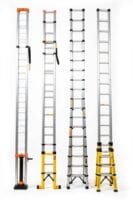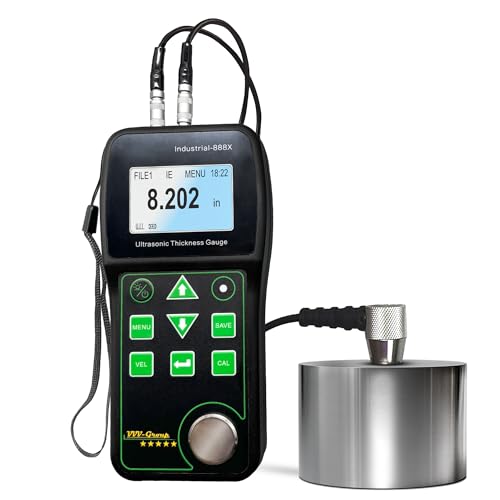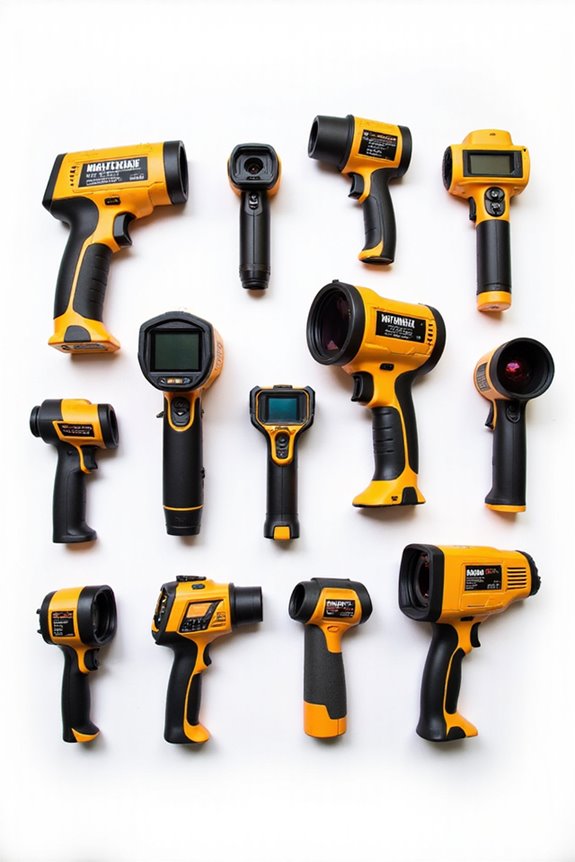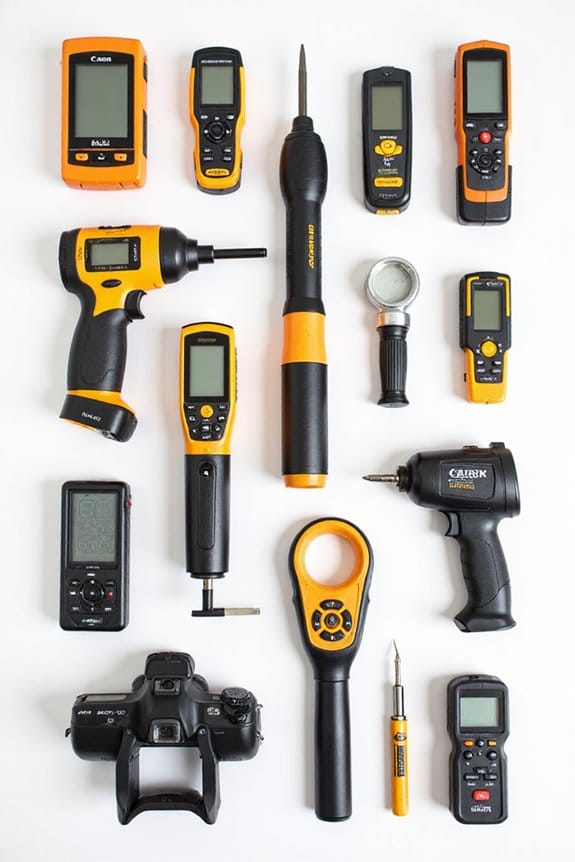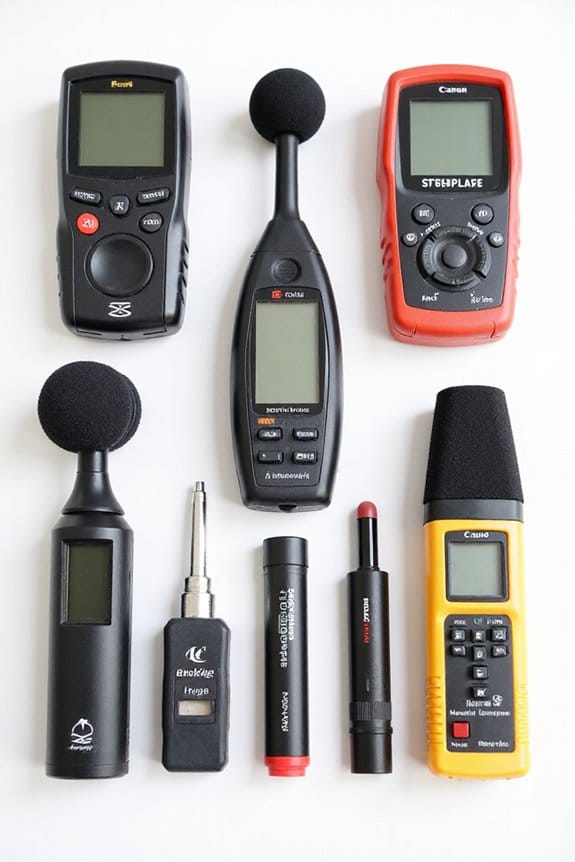As an Amazon Associate, we earn from qualifying purchases. Some links may be affiliate links at no extra cost to you. Although our opinions are based on curated research, we haven't used these products. Articles generated with AI.

5 Best Ultrasonic Thickness Gauges of 2025 – Accurate and Reliable Testing Tools
If you’re looking for the best ultrasonic thickness gauges of 2025, check out these top picks: 1) Industrial-882 for manufacturing precision. 2) Industrial-888 is a user-friendly choice for oil and metallurgical work. 3) Industrial-888X offers ultra-high accuracy for demanding industries. 4) Industrial-886 matches caliper readings for construction needs. 5) Wintact Gauge works on various materials but watch out for calibration quirks. Stick around, and you’ll discover more essentials to pick the perfect tool.
Key Takeaways
- Ultrasonic Thickness Gauge Industrial-888X offers ultra-high accuracy, making it ideal for critical sectors like petroleum and chemical industries.
- Ultrasonic Thickness Gauge Industrial-888 features a user-friendly interface and is suitable for oil, metallurgy, and aerospace applications.
- Ultrasonic Thickness Tester Industrial-886 delivers solid accuracy comparable to caliper readings, perfect for construction and manufacturing needs.
- Wintact Digital Ultrasonic Thickness Gauge delivers fast measurements across various materials but may require regular calibration for reliability.
- Ultrasonic Thickness Gauge (Industrial-882) is favored by professionals in manufacturing and metal processing for its precision and reliable performance.
Ultrasonic Thickness Gauge (Industrial-882)
Ultrasonic Thickness Gauge Industrial-882 / Steel, Metals, Plastic, Glass, PVC, Pipes Thickness...
- HIGH PRECISION INDUSTRIAL THICKNESS GAUGE - The principle of Ultrasonic measurement allows you to measure the thickness of Metal (such as Steel, Aluminum, Copper, etc.),...
- BEST TECHNICAL PARAMETERS - The ultrasonic thickness tester has a wide Range of 0.039 to 8.858 inch /1mm to 225mm with a minimum Resolution: 0.03-10in : 0.001in /...
- CONVENIENT SETTINGS AND MEASUREMENT STATISTICS - Calibration is carried out both using a reference plate and by independently setting the sound Velocity (Sound speed...
If you need a reliable tool for measuring the thickness of various materials—from steel and plastic to glass and PVC—the Ultrasonic Thickness Gauge (Industrial-882) could be your best bet. Here’s why:
- Versatile Measurements: It measures thickness from 0.039 to 8.85 inches, making it suitable for numerous applications.
- User-Friendly Display: The 2.4” HD color LCD adjusts brightness and colors for easy visibility.
- High Precision: Enjoy resolution up to 0.01 mm with customizable sound speed settings.
With a compact design and quick calibration, it’s an excellent backup for pricier models. Just watch the probe wires; they’re a bit delicate. Overall, you’ll find this gauge reliable and powerful for various tasks!
Best For: Professionals in manufacturing, metal processing, and commodity inspection who require a reliable and accurate thickness measurement tool.
Pros:
- Versatile measurement range from 0.039 to 8.85 inches suitable for various materials.
- User-friendly 2.4” HD color LCD with adjustable brightness and customizable interface colors.
- High precision with resolution up to 0.01 mm and customizable sound speed settings.
Cons:
- Probe wires are reported to be fragile and may require careful handling.
- Some users find the overall feel of the device could be improved.
- It may not provide ultra-precision compared to more expensive models.
Ultrasonic Thickness Gauge Industrial-888
Ultrasonic Thickness Gauge Industrial-888 / Echo-Echo Mode Measure Through Coating up to 19.685mils...
- ECHO-ECHO MODE. IE-Mode allows you to measure the thickness of the material through the coating. It is possible to measure through coating thicknesses up to 20 mils and...
- HIGH MEASUREMENT RANGE. PE-Mode allows measurements in the range 0.039-19.68in (1-500mm) for 45#steel and can be used when measuring the thickness of porous materials...
- FUNCTION OF CHECKING THE HOMOGENEITY AND PURITY OF PRECIOUS METALS. The thickness gauge can be used to identify gold bars, silver bars, gold coins, silver coins and other...
The Ultrasonic Thickness Gauge Industrial-888 is an ideal choice for professionals in industries like oil, metallurgy, and aerospace who need precision in measuring material thickness. Here’s what makes it stand out:
- Echo-Echo Mode: Measures thickness through coatings up to 20 mils.
- Versatile Range: Covers 0.039-19.685 inches (1-500 mm), perfect for many materials.
- User-Friendly Display: Shows thickness, battery level, and more—like having a helpful guide.
Users rave about its accuracy but mention a need for clearer instructions. If you want reliable readings, the Industrial-888 might just be your new best friend!
Best For: Professionals in industries such as oil, metallurgy, shipbuilding, and aerospace who require precise material thickness measurements.
Pros:
- High precision with a measurement range of 0.039-19.685 inches (1-500 mm).
- User-friendly display that provides essential information, including thickness and battery level.
- Capable of measuring thickness through coatings up to 20 mils (500 microns).
Cons:
- Some users reported a high battery consumption.
- Limited instructions may leave users needing clearer guidance during operation.
- The probe size can affect readings on concave surfaces, making measurements more challenging.
Ultrasonic Thickness Gauge Industrial-888X
Ultrasonic Thickness Gauge Industrial-888X Echo-Echo Mode Measure Through Coating up to 19.685mils...
- ECHO-ECHO MODE: The IE-mode in this ultrasonic thickness gauge allows you to accurately measure material thickness through coatings without having to remove the surface...
- LARGE MEASUREMENT RANGE: The PE-mode in this thickness gauge provides a wide measurement capability, making it ideal for a variety of materials and industrial...
- UNIFORMITY AND PURITY FUNCTION: This ultrasonic thickness gauge has a specialized function to evaluate the uniformity and purity of precious metals, ensuring reliable...
Looking for a reliable ultrasonic thickness gauge that can handle tough industrial environments? The Industrial-888X might be your best bet! Here’s what you’ll love about it:
- ECHO-ECHO MODE: This nifty feature measures thickness through coatings, up to 20 mils, so you can skip the messy removal process.
- LARGE RANGE: It measures from 0.039 to 19.68 inches, making it perfect for various materials, including porous ones.
- ULTRA-HIGH ACCURACY: Count on it for precise readings in high-risk applications, ensuring safety and quality.
Despite some minor issues, like unclear instructions for newbies, users generally rave about its performance and cost-effectiveness!
Best For: Professionals in industries like petroleum, chemical, and metalworking who require accurate non-destructive testing of material thickness.
Pros:
- ECHO-ECHO MODE allows measurement through coatings without removal, saving time and preserving materials.
- Large measurement range from 0.039 to 19.68 inches accommodates various materials, including porous ones.
- Ultra-high accuracy ensures reliable readings even in challenging environments, enhancing safety and quality control.
Cons:
- Instructions may lack clarity for novice users, leading to a learning curve.
- Limited software functionality does not allow for configuring the meter or saving named presets for different metals.
- Some users report potential scratching of coins during measurements.
Ultrasonic Thickness Tester Industrial-886
Ultrasonic Thickness Tester Industrial-886 / Digital Metals Thickness Gauge with Range...
- HIGH PRECISION INDUSTRIAL ULTRASONIC THICKNESS GAUGE - The principle of Ultrasonic measurement allows you to measure the thickness of Metal (such as Steel, Aluminum,...
- BEST TECHNICAL PARAMETERS - Ultrasonic thickness tester has a wide Range of 0.04~15.75in / 1~400mm with Resolution: 0.01in / 0.01mm. This allows this measuring instrument...
- CONVENIENT SETTINGS AND MEASUREMENT STATISTICS - Calibration is carried out both using a reference plate and by independently setting the Velocity sound (Sound speed...
For professionals in industries like construction or manufacturing, the Ultrasonic Thickness Tester Industrial-886 stands out as a reliable tool that simplifies the measurement of material thickness.
- Versatile Measurement: It measures from 0.04 to 15.75 inches (1-400mm) in various materials—think metals, plastics, ceramics, and even glass.
- User-Friendly: With an easy menu, adjusting settings or calibrating is a breeze.
- Solid Accuracy: Many users report precision that even matches caliper readings.
- Calibration Made Easy: Use a reference plate or set sound velocity independently.
Best For: Professionals in construction, manufacturing, and other industries requiring precise measurement of material thickness.
Pros:
- High measurement range (0.04-15.75 in / 1-400 mm) for various materials.
- Intuitive user interface for easy calibration and settings adjustment.
- Reliable accuracy that aligns with caliper readings for dependable results.
Cons:
- Some users desire clearer instructions for initial setup and calibration procedures.
- Limited detail in the user manual may require a learning curve for new users.
- Potential for confusion among users not familiar with ultrasonic measurement principles.
Wintact Digital Ultrasonic Thickness Gauge Tester Meter for Measuring Materials
Wintact Digital Ultrasonic Thickness Gauge, Range 0.039 to 11.81 in with Probe for Measuring Metal...
- Fast & Accurate: The ultrasonic thickness gauge measuring ranges from 0.039 to 11.81 in/1 to 300mm, Resolution: 0.01mm. you can get accurate (±0.5%H+0.05mm) readings in...
- Adjustable Sound Velocity: You can be easily changed sound velocity from 1000 to 9999m/s to get the most accurate results. it continually displays/updates average,...
- Multi-Functional: 2.4″HD color screen display with backlit & 5 selectable color display, storage up to 500 data, statistic view, calibration, auto-off, and restores...
If you’ve ever needed to measure material thickness with precision, the Wintact Digital Ultrasonic Thickness Gauge Tester Meter stands out as a top choice. Here’s why:
- Measuring Range: It covers from 0.039 to 8.85 inches (1 to 225 mm), catering to various materials.
- Fast and Accurate: With a resolution of 0.01 mm and accuracy of ±0.5%, it gives reliable results in about 0.5 seconds.
- User-Friendly: Just turn it on, apply gel, touch the surface, and you’re good to go!
- Versatile Usage: Works well on metals, plastics, and more.
Just remember to calibrate carefully for the best results!
Best For: Those seeking a reliable and user-friendly tool for measuring material thickness across various metal and nonmetal applications.
Pros:
- Wide measuring range from 0.039 to 8.85 inches, suitable for various materials.
- Fast measurement time of approximately 0.5 seconds, enhancing efficiency.
- User-friendly operation requiring simple steps to achieve accurate readings.
Cons:
- Reports of inaccuracies after initial use may affect reliability.
- Calibration issues encountered with different material thicknesses.
- Concerns about product durability and functionality over time.
Factors to Consider When Choosing an Ultrasonic Thickness Gauge

When you’re picking an ultrasonic thickness gauge, several factors can greatly impact your choice. You’ll want to think about measurement accuracy, material compatibility, and the range of capabilities that fit your needs. Plus, a user-friendly design and good calibration features will make your measuring tasks much smoother—after all, who enjoys wrestling with confusing gadgets?
Measurement Accuracy Requirements
Choosing the right ultrasonic thickness gauge is a bit like finding the perfect pair of shoes; you want the perfect fit for your needs. Here are some key factors to keep in mind:
- Measurement Resolution: Look for gauges with resolutions between 0.01 mm to 0.01 in for sharp accuracy.
- Accuracy Specifications: Understand how accuracy is presented, like ±0.5%H + 0.05mm—this matters for reliability.
- Sound Velocity Adjustment: A gauge that lets you set velocities between 1000 to 9999 m/s can adapt to different materials easily.
- Calibration is Key: Regularly calibrating with reference plates keeps your readings reliable.
Trust me, precise measurements will save you time and headaches down the line!
Material Compatibility Considerations
Selecting an ultrasonic thickness gauge that suits your specific needs means considering the materials you’ll be working with. Here are some key factors:
- Material Type: Make certain the gauge can handle the specific materials, like metals, plastics, ceramics, or glass. Not all gauges are created equal!
- Coating Measurement: If you need to measure through coatings, find a model that can do this, ideally up to 20 mils (500 microns). It’ll help keep surfaces intact.
- Sound Speed Adjustment: Check the sound speed range, usually between 1000 to 9999 m/s. This guarantees accuracy across different materials.
- Porous Materials: If you’ll measure porous materials like cast iron, verify the gauge’s technology compatibility—it can make a big difference!
Range of Measurement Capability
Understanding the range of measurement capability is essential for anyone in the market for an ultrasonic thickness gauge. Here are key points to keep in mind:
- Measurement Range: Gauges can measure from 0.039 inches (1 mm) to 19.685 inches (500 mm). Choose one that fits your material.
- Material Compatibility: Certain gauges excel at specific materials like metals or plastics. Always match the gauge to your application.
- Sound Speed Settings: Many models let you adjust sound speed based on the material, vital for accurate readings.
- Coating Measurement: Some can measure through coatings up to 20 mils (500 microns)—handy for painted surfaces!
- Resolution Counts: Look for gauges with a precision range of 0.01 mm or 0.01 inches to achieve the accuracy you need.
User-Friendly Interface Design
When you’re on the hunt for an ultrasonic thickness gauge, a user-friendly interface design can make all the difference, especially if you plan to use it regularly. Here are some key features to look for:
- Clear Display: Make certain it shows thickness, coupling state, battery level, and calibration state. You want the essentials without squinting!
- Customizable Settings: Adjustable backlight brightness and colors? Yes, please! This is great for varied lighting conditions.
- Simple Navigation: A straightforward menu lets you choose the sound frequency or calibrate without a headache.
- Data Saving: Look for the ability to save measurements with timestamps, helping you track results over time.
- Intuitive Buttons: Easy-to-use buttons guarantee you’re not fumbling around, even in tough environments.
Happy gauging!
Calibration and Adjustment Features
Accuracy is the name of the game in ultrasonic thickness gauging, and that’s where calibration and adjustment features come into play. Here are key aspects to take into account:
- Calibration Methods: Some gauges let you calibrate using a reference plate or adjust sound velocity; both enhance accuracy.
- Adjustable Sound Speed: Look for gauges that offer sound speed settings from 1000 to 9999 m/s. This customization helps for different materials.
- Automatic Calibration: If you can find a model that automatically calibrates against known thicknesses, it’ll save you time.
- Regular Calibration: Don’t skip this! It’s essential, especially with varying material thicknesses and environmental conditions.
- Factory Reset: A reset option is handy for restoring default settings if things go awry.
Happy gauging!
Portability and Weight Factors
You’ve probably noticed that portability can make or break your experience with an ultrasonic thickness gauge. Here are some key factors to weigh:
- Compact Design: Choose a gauge that easily slips into your hand, allowing quick access whenever you need it.
- Weight Matters: Look for lightweight models that reduce fatigue during long measurement sessions. You want comfort while working!
- Durable Build: Select a rugged construction that can handle tough industrial environments yet remains portable.
- Battery Life: Opt for devices with extended battery life and efficient charging options to avoid constant downtime.
Balancing these elements will enhance your efficiency and make your measuring tasks less of a chore. Trust me, you’ll appreciate the difference!
Data Storage and Connectivity
After reflecting on how portability and weight can greatly impact your experience with an ultrasonic thickness gauge, it’s time to talk about another fundamental aspect: data storage and connectivity. Here are key factors to take into account:
- Storage Capacity: Look for models that save up to 500 measurements, timestamps, and sound velocity data. Keep your info organized!
- Connectivity Options: Choose devices that connect to PCs for easy data export in XLSX or PDF formats. Who doesn’t love convenient record-keeping?
- User Interface: Make sure it displays important info like thickness values and calibration status. A clear display makes your job easier.
- Software Compatibility: Some gauges offer measurement management software—just check if it’s compatible with your operating system.
- Data Access: Opt for straightforward access to stored data for efficient field use. Trust me, you’ll appreciate it!
Price vs. Performance Balance
When it comes to choosing an ultrasonic thickness gauge, striking the right price vs. performance balance can feel like a puzzle. Here are a few factors to take into account:
- Measurement Range: Higher-priced models can measure up to 19.68 inches (500 mm) versus lower-end options at 8.85 inches (225 mm).
- Accuracy and Resolution: Premium gauges often provide resolutions as fine as 0.01 mm and accuracies around ±0.5%H + 0.05 mm.
- Additional Features: Echo-Echo Mode and data storage can justify a higher cost, especially in industrial settings.
Think about what you need. If your tasks require precise measurements and advanced features, investing more makes sense. But for general use, lower-cost options deliver reliable performance without breaking the bank.
Frequently Asked Questions
What Materials Can Ultrasonic Thickness Gauges Measure Effectively?
Ultrasonic thickness gauges measure a variety of materials effectively. Here’s a quick list:
- Metals – They work great on steel, aluminum, and copper.
- Plastics – You can also measure different types of plastics.
- Glass – These gauges provide reliable readings on glass thickness.
Just remember, they need good acoustic properties for accurate results. You’ve got this! So, whether you’re checking pipes or inspecting aircraft, ultrasonic gauges are your trusty sidekicks.
How Often Should an Ultrasonic Thickness Gauge Be Calibrated?
Did you know that having your ultrasonic thickness gauge calibrated every six months can improve measurement accuracy by up to 15%? Here’s how often you should calibrate yours:
- Routine Calibration: Every six months for most users.
- High-Usage Environments: Consider every three months if you use it daily.
- New Equipment: Always after the initial purchase.
Staying on top of calibrations guarantees you get reliable results—so don’t skip it! It’s worth the effort.
Can Ultrasonic Thickness Gauges Work in Extreme Temperatures?
Yes, ultrasonic thickness gauges can work in extreme temperatures, but it depends on the model. Here’s what you should consider:
- Operating Range: Check the manufacturer’s specifications for temperature limits.
- Calibration: Extreme temps might affect calibration; verify it’s accurate.
- Material: Some materials may behave differently under heat or cold.
Are There Any Safety Precautions While Using These Gauges?
Safety’s essential when using ultrasonic thickness gauges. Here are some simple steps to stay safe:
- Secure Setup: Confirm your gauge’s stability before starting. A shaky situation’s a no-go.
- Protective Gear: Always wear gloves and goggles. It’s better to be safe than sorry!
- Battery Basics: Check that your battery’s charged and in good shape. Dead batteries can lead to mishaps.
Keep it careful, and you’ll gauge like a pro!
What Is the Typical Lifespan of an Ultrasonic Thickness Gauge?
The typical lifespan of an ultrasonic thickness gauge usually ranges from 5 to 10 years, depending on usage and care. Here’s what you should keep in mind:
- Quality Matters: Invest in well-made models; they tend to last longer.
- Maintenance: Regularly check for calibration and clean the probes.
- Storage: Store it in a dry, safe place when you’re not using it.



